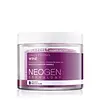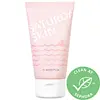What's inside
What's inside
 Key Ingredients
Key Ingredients

 Benefits
Benefits

 Concerns
Concerns

 Ingredients Side-by-side
Ingredients Side-by-side

Water
Skin ConditioningButylene Glycol
HumectantGlycerin
HumectantAlcohol Denat.
AntimicrobialPEG/PPG-17/6 Copolymer
SolventWine Extract
AntioxidantSodium Hyaluronate
HumectantResveratrol
AntioxidantCarbomer
Emulsion StabilisingVitis Vinifera Seed Extract
AntimicrobialRubus Fruticosus Fruit Extract
AstringentRubus Idaeus Fruit Extract
AstringentVaccinium Angustifolium Fruit Extract
Skin ProtectingCoptis Japonica Extract
AntimicrobialTartaric Acid
BufferingGlycolic Acid
BufferingLactic Acid
BufferingTromethamine
BufferingCI 19140
Cosmetic ColorantCI 17200
Cosmetic ColorantCI 42090
Cosmetic ColorantBenzophenone-5
UV AbsorberDisodium EDTA
Phenoxyethanol
PreservativeEthylhexylglycerin
Skin ConditioningPEG-60 Hydrogenated Castor Oil
Emulsifying1,2-Hexanediol
Skin ConditioningParfum
MaskingWater, Butylene Glycol, Glycerin, Alcohol Denat., PEG/PPG-17/6 Copolymer, Wine Extract, Sodium Hyaluronate, Resveratrol, Carbomer, Vitis Vinifera Seed Extract, Rubus Fruticosus Fruit Extract, Rubus Idaeus Fruit Extract, Vaccinium Angustifolium Fruit Extract, Coptis Japonica Extract, Tartaric Acid, Glycolic Acid, Lactic Acid, Tromethamine, CI 19140, CI 17200, CI 42090, Benzophenone-5, Disodium EDTA, Phenoxyethanol, Ethylhexylglycerin, PEG-60 Hydrogenated Castor Oil, 1,2-Hexanediol, Parfum
Water
Skin ConditioningGlycerin
HumectantCellulose
AbsorbentButylene Glycol
HumectantAlcohol Denat.
AntimicrobialDipropylene Glycol
HumectantPentylene Glycol
Skin ConditioningCeteareth-12
EmulsifyingCitrus Limon Peel Oil
MaskingJuniperus Mexicana Oil
MaskingCitrus Aurantium Dulcis Peel Oil
MaskingCitrus Grandis Peel Oil
MaskingEucalyptus Globulus Leaf Oil
PerfumingLavandula Angustifolia Oil
MaskingRosmarinus Officinalis Leaf Oil
MaskingAloe Barbadensis Leaf Polysaccharides
EmollientPhoenix Dactylifera Seed
Skin Conditioning1,2-Hexanediol
Skin ConditioningTriethanolamine
BufferingPolysorbate 20
EmulsifyingCaprylyl Glycol
EmollientLactose
HumectantHydroxypropyl Methylcellulose
Emulsion StabilisingEthylhexylglycerin
Skin ConditioningJojoba Esters
EmollientHydrogenated Lecithin
EmulsifyingMannitol
HumectantAscorbyl Palmitate
AntioxidantTocopheryl Acetate
AntioxidantCholesterol
EmollientPEG-800
HumectantBromelain
Skin ConditioningPapain
Skin ConditioningAscorbic Acid
AntioxidantSh-Oligopeptide-1
Skin ConditioningSh-Polypeptide-1
Skin ConditioningSh-Oligopeptide-2
Skin ConditioningSh-Polypeptide-22
Skin ConditioningSh-Polypeptide-45
Skin ConditioningSh-Polypeptide-8
HumectantSh-Polypeptide-9
Skin ConditioningCarbomer
Emulsion StabilisingDisodium EDTA
CI 77007
Cosmetic ColorantWater, Glycerin, Cellulose, Butylene Glycol, Alcohol Denat., Dipropylene Glycol, Pentylene Glycol, Ceteareth-12, Citrus Limon Peel Oil, Juniperus Mexicana Oil, Citrus Aurantium Dulcis Peel Oil, Citrus Grandis Peel Oil, Eucalyptus Globulus Leaf Oil, Lavandula Angustifolia Oil, Rosmarinus Officinalis Leaf Oil, Aloe Barbadensis Leaf Polysaccharides, Phoenix Dactylifera Seed, 1,2-Hexanediol, Triethanolamine, Polysorbate 20, Caprylyl Glycol, Lactose, Hydroxypropyl Methylcellulose, Ethylhexylglycerin, Jojoba Esters, Hydrogenated Lecithin, Mannitol, Ascorbyl Palmitate, Tocopheryl Acetate, Cholesterol, PEG-800, Bromelain, Papain, Ascorbic Acid, Sh-Oligopeptide-1, Sh-Polypeptide-1, Sh-Oligopeptide-2, Sh-Polypeptide-22, Sh-Polypeptide-45, Sh-Polypeptide-8, Sh-Polypeptide-9, Carbomer, Disodium EDTA, CI 77007
 Reviews
Reviews

Ingredients Explained
These ingredients are found in both products.
Ingredients higher up in an ingredient list are typically present in a larger amount.
1,2-Hexanediol is a synthetic liquid and another multi-functional powerhouse.
It is a:
- Humectant, drawing moisture into the skin
- Emollient, helping to soften skin
- Solvent, dispersing and stabilizing formulas
- Preservative booster, enhancing the antimicrobial activity of other preservatives
Alcohol Denat. is an alcohol with a denaturant property. It is created by mixing ethanol with other additives.
This ingredient gets a bad rep because it is irritating and drying - mostly due to its astringent property. Astringents draw out natural oils in tissue, constricting pores and leaving your skin dried out.
However, alcohol denat. is not all that bad.
Due to its low molecular weight, alcohol denat. tends to evaporate quickly. One study on pig skin found half of applied alcohol evaporated in 10 seconds and less than 3% stayed on skin.
This also helps other ingredients become better absorbed upon application.
Studies are conflicted about whether this ingredient causes skin dehydration. One study from 2005 found adding emollients to propanol-based sanitizer decreased skin dryness and irritation. Another study found irritation only occurs if your skin is already damaged.
Small amounts of alcohol are generally tolerated by oily skin or people who live in humid environments.
The rule of thumb is if this alcohol is near the end of an ingredients list, it will probably not affect your skin much.
Also...
This ingredient has antimicrobial and solvent properties.
The antimicrobial property helps preserve products and increase their shelf life. As a solvent, it helps dissolve other ingredients.
Other types of astringent alcohols include:
Learn more about Alcohol Denat.Butylene Glycol (or BG) is used within cosmetic products for a few different reasons:
Overall, Butylene Glycol is a safe and well-rounded ingredient that works well with other ingredients.
Though this ingredient works well with most skin types, some people with sensitive skin may experience a reaction such as allergic rashes, closed comedones, or itchiness.
Learn more about Butylene GlycolCarbomer is a polymer of acrylic acid. Its main role is to create a gel consistency.
A high amount of carbomer can cause pilling or balling up of products. Don't worry, most products contain 1% or less of carbomer.
Disodium EDTA plays a role in making products more stable by aiding other preservatives.
It is a chelating agent, meaning it neutralizes metal ions that may be found in a product.
Disodium EDTA is a salt of edetic acid and is found to be safe in cosmetic ingredients.
Learn more about Disodium EDTAEthylhexylglycerin (we can't pronounce this either) is commonly used as a preservative and skin softener. It is derived from glyceryl.
You might see Ethylhexylglycerin often paired with other preservatives such as phenoxyethanol. Ethylhexylglycerin has been found to increase the effectiveness of these other preservatives.
Glycerin is already naturally found in your skin. It helps moisturize and protect your skin.
A study from 2016 found glycerin to be more effective as a humectant than AHAs and hyaluronic acid.
As a humectant, it helps the skin stay hydrated by pulling moisture to your skin. The low molecular weight of glycerin allows it to pull moisture into the deeper layers of your skin.
Hydrated skin improves your skin barrier; Your skin barrier helps protect against irritants and bacteria.
Glycerin has also been found to have antimicrobial and antiviral properties. Due to these properties, glycerin is often used in wound and burn treatments.
In cosmetics, glycerin is usually derived from plants such as soybean or palm. However, it can also be sourced from animals, such as tallow or animal fat.
This ingredient is organic, colorless, odorless, and non-toxic.
Glycerin is the name for this ingredient in American English. British English uses Glycerol/Glycerine.
Learn more about GlycerinWater. It's the most common cosmetic ingredient of all. You'll usually see it at the top of ingredient lists, meaning that it makes up the largest part of the product.
So why is it so popular? Water most often acts as a solvent - this means that it helps dissolve other ingredients into the formulation.
You'll also recognize water as that liquid we all need to stay alive. If you see this, drink a glass of water. Stay hydrated!
Learn more about Water